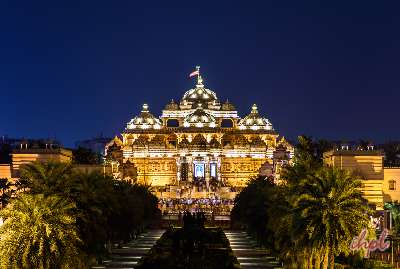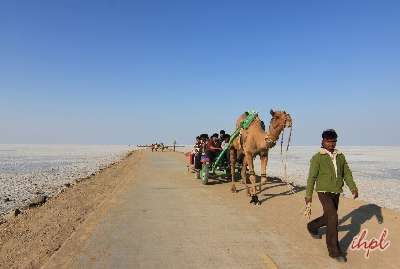The history of Bhuj can be known from the remnants that witnessed many important events that have impacted human civilization. The historical background of Bhuj claims to have seen the social upbringing of the Indus Valley civilization and the rise and fall of many rulers like Rajputs, Sultans, local Kutchi rulers, and more. In addition, Bhuj witnessed the exile of the Pandavas during the Mahabharata and the political invasion with the coming of Alexander the Great.
Today, we can see so many industries setting up in Bhuj. Central and State governments have taken many steps to develop the city and promote Bhuj tourism. It is the administrative headquarters of the Kutch District as well. Also known as “Old Walled City”, Bhuj is home to centuries-old monuments, a modern town at Gandhidham, and a state-of-the-art port at Kandla.
Explore 13 Days Gujarat Tour Package with Mumbai
We have discussed the history of Bhuj in detail below.
Bhuj’s Prehistoric Period
Bhuj played a significant role in many historical events that happened during the early civilizations of the Indian subcontinent. It was linked with ancient world destinations like Greece, the Middle East, and Zanzibar. Several archeological remains have been found in Bhuj in the form of tombs, palaces, buildings, etc., that promote the city’s rich cultural heritage of prehistoric times.
Khadir, an island in the Great Rann of Kutch in Gujarat, has Harappa and Mohenjo Daro’s remains excavated since 1990. This evidence proves that Bhuj has been a part of the Harappan Civilization. The city also finds mention in various writings of famous philosophers, thinkers, and writers. For example, in Strabo’s writing (who was a Greek geographer, philosopher, and historian between 66 BC and 24 AD), Bhuj is cited as a city named Tej.
Bhuj between the 8th to 16th Centuries AD
Samma Rajputs ruled over Bhuj for a long time. They belonged to Sindh (a region of British India from 1st April 1936 to 1947) and ruled Kutch under their control from the region. However, from the mid-16th century, with the coming up of the Jadeja Rajput rulers, Bhuj stood more important as a city than it was.
Bhuj was founded in 1510 by the local ruler Maharao Hamir. Bhuj was made the capital during the reign of Rao Khengarji I in 1549. The city derived its name from the Bhujiyo Dungar (a hill), which overlooks the city from a nearby hill. There is a fable that this hill was home to Bhujang, the Great Serpent. A temple is located on the top of the hill, dedicated to the Great Serpent.
Bhuj Pre-Independence
Towards the end of the 16th century, Mughal rulers took the city of Bhuj under their control. The local power was given to Rajput rulers, and the Mughals were centrally controlling the administration. King Bharmal I was a local king who often sent gifts to Mughal rulers to please them.
As years went by, local kings permitted the pilgrims to Mecca to pass through Bhuj city free of cost. This exempted the local kings from paying taxes to the Mughal rulers. Also, the local kings were entitled to make their own currency called “kori”. As the Mughal Empire declined in the early 18th century, the ruler of Kutch, Rao Godiji, fortified Bhuj. Fifty-one guns were also installed.
In 1741, Lakhpatji I emerged as a new ruler of Bhuj, a poet who had an interest in arts and literature. Under his rule, Bhuj saw massive architectural shifts like the building of the Aina Mahal. Ramsinh Malam was the artisan who built the Aina Mahal and was training in Holland at that time. Many poets, dancers, and singers thrived under Lakhpati I’s reign, and Kutch was also developed culturally.
Under the reign of Lakhpatji I’s successor, Raydhan II, the city of Bhuj started to decline. Raydhan II converted to Islam and forcefully converted his subjects to Islam. After he died, the conditions returned to normal, and all religions were treated equally.
Browse through our Gujarat Tour Packages from Hyderabad, Gujarat Tour Packages from Pune, Dwarka Tour Package from Kolkata
Bhuj During the British Rule in India
In 1815, Britishers captured Bhujiyo Hill and granted the local king regional autonomy. They also declared Kutch a British Colony. Britishers didn’t take Kutch’s rule directly but became its administrative head. Also, they tried to maintain peace between the Kutch people and others in surrounding areas.
In the 19th century, Pragmalji II came to the throne and was commissioned to build the Prag Mahal. Many palaces and buildings were constructed during his rule. During the British rule in India, Bhuj remained an independent princely state.
Bhuj’s history is evident from the monuments and the havelis that stand with great pride as a traditional building in today’s contemporary world. Instead, traces of the elegance of the majestic Jadeja Dynasty that ruled over Bhuj are evident from the palaces and the “havelis” built during that time.
Bhuj Post-Independence
After India gained independence in 1947, Kutch became a part of India, and its neighbor Sindh got it in Pakistan. However, Bhuj continued to be a place of cultural and historical importance. Also, due to its proximity to the Pakistan border, the Indian Air Force made the city a significant base.
The history of Bhuj still needs to mention that two deadly earthquakes have tormented the city. The spirit of the people living in Bhuj is clear from the fact that the city has restored its life and color by rebuilding the city. The earthquakes of 1819 and 2001 hit the city badly.
If you wish to explore the city of Bhuj, reach out for an Indian Holiday. We offer Bhuj tour packages that cover the prominent tourist places in the city on private guided tours. Meals and stays are provided with the Bhuj package to ensure a hassle-free tour. You can customize your tour as per your budget and needs.
Check out Gujarat Tour Packages, Sasan Gir Tour Packages, Kutch Tour packages, Vadodara Tour Packages, Porbandar tour packages, Mandvi Tour Packages, Kutch Tour packages, Saputara Tour Packages, Rajkot Tour Packages







